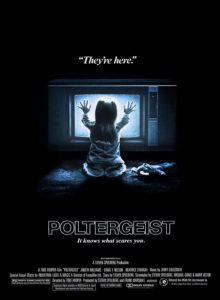The first big budget Hollywood production by THE TEXAS CHAINSAW MASSACRE’s Tobe Hooper, although POLTERGEIST’S actual director has long been in question. It’s widely alleged that executive producer Steven Spielberg was the true creative force behind the film, and it definitely has the “Spielberg touch.” Maybe that’s why I’m not too high on it.
Few movies in the Spielberg cannon have been more fraught than 1982’s POLTERGEIST. The legal issues surrounding it are so grievous that a writer who attempted to write a book about the film was halted by Spielberg’s Amblin Entertainment.
To begin with, actor/writer Paul Clemens filed suit against Spielberg, claiming he plagiarized a Clemens script called HOUSEBOUND. The case was settled out of court. The legendary horror scribe Richard Matheson also raised a stink, about elements from his TWILIGHT ZONE teleplay “Little Girl Lost” that turned up in POLTERGEIST. It’s widely believed that Matheson was hired as a screenwriter on the Spielberg-produced TWILIGHT ZONE: THE MOVIE to head off a possible lawsuit.
Then there’s the issue of who “really” directed POLTERGEIST. Tobe Hooper was the credited director, but Spielberg has never made any secret of the fact that he always wanted to helm the film. He was prevented from doing so because he was working on E.T. at the time (Director’s Guild rules forbid directing two films simultaneously), but Spielberg largely storyboarded POLTERGEIST himself and reported to the set every day. The cast and crew have remained cagey about the degree of his influence, but everyone seems to agree that Mr. Spielberg made his presence felt.
As if all that weren’t enough, there seems to be a “POLTERGEIST curse” at work on the cast. Supporting player Dominique Dunne was beaten to death by her boyfriend, while Will Sampson and Julian Beck from POLTERGEIST II: THE OTHER SIDE (which neither Spielberg nor Hooper were involved with) both died, as did 12 year old Heather O’Rourke during post-production of POLTERGEIST III.
The Freelings are a normal middle class family living in a trendy (for the eighties) Southern California home. One night the youngest daughter Carol Anne (O’Rourke) is found out of bed and talking to a staticy TV screen—she later claims she’s addressing the “TV People.” From there weird things begin happening, including articles of furniture moving around by themselves. Then comes the episode in which Carol Anne’s brother Robby (Oliver Robins) is grabbed by a tree outside his room while Carol Anne is sucked into her closet—and apparently into another dimension.
Robbie is rescued from the evil tree by his father Steve (Craig T. Nelson), but Carol Anne is nowhere to be found. Her voice, however, can be heard loud and clear. She reports there’s “somebody here” with her, a duplicitous creature that Tangina (Zelda Rubinstein), a diminutive psychic, dubs “The Beast.” Tangina was called in to exorcise the house’s demons, and seems to know a lot about the nature of this particular haunting—including the fact that the entrance to the realm where Carol Anne is being held is her bedroom closet, while the exit is the living room ceiling. Carol Anne’s mom Diane (Jobeth Williams) proves this by walking into the closet and falling out of the ceiling with Carol Anne in her arms.
But the scariness isn’t over. Diane is manhandled by invisible forces and Carol Anne and Robbie are nearly sucked back into the deadly closet, which turns into a giant throat. All manage to escape as coffins burst up through the floor, unearthing a long-buried secret: the house was constructed over a cemetery whose headstones were moved elsewhere while the bodies stayed put.
Recognizing who did what on POLTERGEIST isn’t especially difficult. Parts of the film seem quite Tobe Hooper-like, notably the superbly controlled craziness of the Diane-entering-the-closet sequence (which will resonate with fans of THE TEXAS CHAINSAW MASSACRE). But Steven Spielberg’s fingerprints are unmistakable, from the carefully storyboarded camerawork to the overpowering Jerry Goldsmith score to the really horrible scripting.
Over the years Spielberg has told anyone who will listen that he heavily rewrote the script of POLTERGEIST (it’s credited to Spielberg, Michael Grais and Mark Victor). Anyone who’s seen CLOSE ENCOUNTERS OF THE THIRD KIND or A.I., Spielberg’s other attempts at screenwriting, well knows his talents are not in the writing sphere. He proves that with the inconsistent and incoherent narrative of POLTERGEIST, in which lots of promising ideas are strung together with little in the way of a unifying conception. Explanations are scant, as is clarification (who/what are “The Beast” and the “TV People?” Why does Tangina declare the house “clean” when it clearly isn’t?), and the special effects are vastly overused in Spielberg’s patented More-is-Better credo.
One area where the film excels is in casting. POLTERGEIST hails from the days when Spielberg really took care with his casting (unlike his more recent actor-of-the-moment picks). Jobeth Williams and Craig T. Nelson are note-perfect in the lead roles, as are the supporting players—Zelda Rubinstein (with her downright otherworldly southern accented voice) in particular. The suburban setting is also unique and interesting, an effective reversal of the traditional old dark mansions of most haunted house movies. So POLTERGEIST has its good points, but not enough of them.
Vital Statistics
POLTERGEIST
Metro Goldwyn Meyer
Director: Tobe Hooper (and/or Steven Spielberg)
Producers: Steven Spielberg, Frank Marshall
Screenplay: Steven Spielberg, Michael Grais, Mark Victor
Cinematography: Matthew F. Leonetti
Editing: Michael Kahn
Cast: Jobeth Williams, Craig T. Nelson, Heather O’Rourke, Oliver Robins, Beatrice Straight, Dominique Dunne, Zelda Rubenstein, Michael McManus, Virginia Kiser, Martin Casella, Richard Lawson, Lou Perryman

